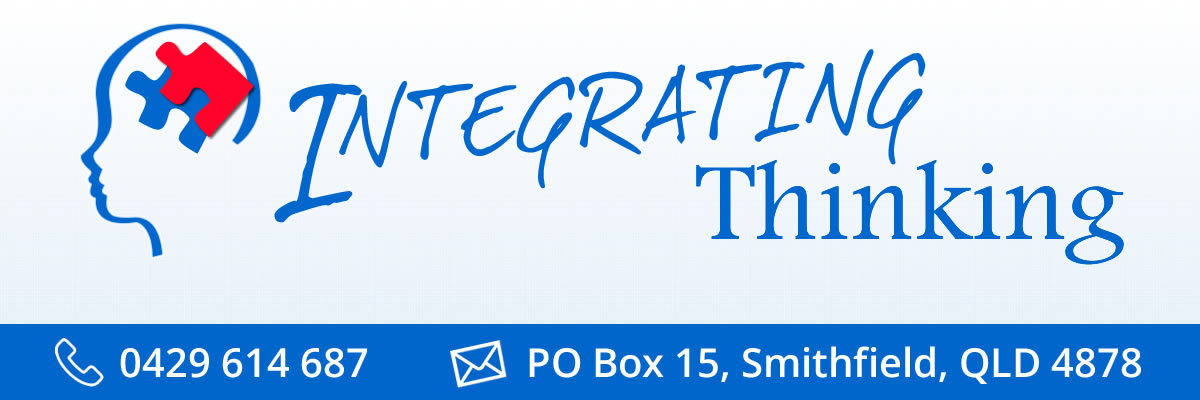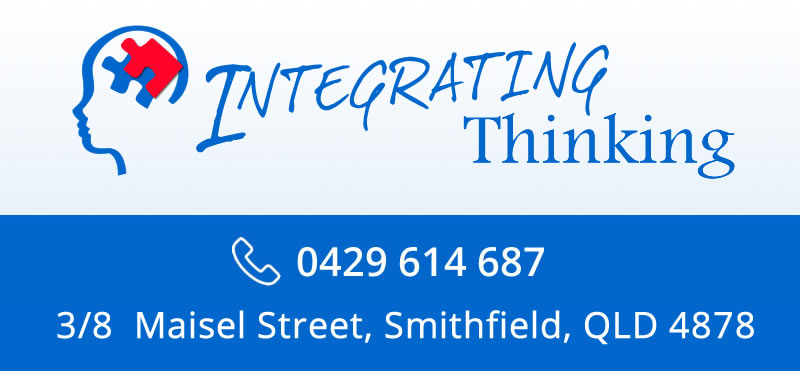How the Body Tells the Learning Story.
Crack the body language code that tells you how the brain and body work together to support learning.
Educators:
Can you read the body language of learning? Do you understand the body cues that tell you how your students learn? Can you identify how their body supports their brain in learning activities, and, at times, how their body can actually interfere with their learning?
Do you struggle with identifying and explaining the “learning blocks” your students seem to have, and then working out how to address them in your planning and teaching? How do you describe and explain your approach to others?
Have you found yourself saying: “This student just doesn’t seem ready to learn. It seems like they don’t even want to be here. Their body language seems to say they are disengaged from learning!” ?
 “How the Body Tells a Learning Story” TM helps you read and understand the body language of learning your students are showing you every day. It tells you HOW your students learn.
“How the Body Tells a Learning Story” TM helps you read and understand the body language of learning your students are showing you every day. It tells you HOW your students learn.
“How the Body Tells a Learning Story” TM helps you crack the body code of learning and explain what you see. It helps you know your students better, understand how they are learning and understand some of the difficulties they may be having in learning.
“How the Body Tells the Learning Story” TM is about knowing your students and how they learn. (AITSL#1)
Sign me up for the wait-list & course updates.
“How the Body Tells a Learning Story” TM is based on the science and processes of neuro-development that underpin the way we learn. It is designed especially for educators and those who help children learn (including support staff and others.)
“How The Body Tells a Learning Story” TM is an introduction to our “Body to Brain Learning” TM approach to learning and teaching, explaining why this approach is important to include it in your professional toolkit.
“I explain how the body helps support learning and how the body helps develop the brain. We know learning is more than a cognitive, head based task — it’s also a body function so let’s understand that better, after all, it’s the body that sets the foundations for how we learn with our brain.” [Dr Christine Payard (PhD), your course presenter]
Here are 3 things you’ll start in your practice. You will:
-
- grow your understanding of how students use their bodies to learn (and possible consequent behaviours and learning challenges they may have if their body systems are immature), and, be better able to explain that to others (parents, colleagues, administrators and leaders).
-
- identify what may be getting in the way of your student’s learning success using observational tools and your growing understanding of how the body tells you a learning story.
-
- get/find/create ideas and strategies to help the students who may have neuro-motor and sensory immaturity issues that are impacting their learning. “Knowing where to look helps heaps!”
“You will learn what to look for, understand why this perspective is so important for learning success and be able to explain it better. We focus on the clues and cues in your students learning body language.” [Dr Christine Payard (PhD)]
Here’s what some of the teachers have said after finishing our courses:
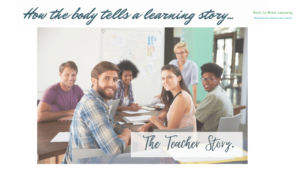 “Now that I know what to look for in their body learning story, I can respond faster to provide them [my students] with the support they need.”
“Now that I know what to look for in their body learning story, I can respond faster to provide them [my students] with the support they need.”
(Suzanne, a Queensland Pre-School Teacher)
“I feel like I’ve found the key to Aladdin’s Cave!” and “It has changed my way of working… It has changed our school.”
(Carleen, a Victorian Primary School Teacher)
COURSE DETAILS:
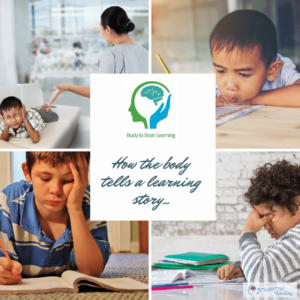 Cracking the Body Language Code that Tells Us How the Body & Brain Work Together to Support Learning.
Cracking the Body Language Code that Tells Us How the Body & Brain Work Together to Support Learning.
What you will learn:
- how the body supports learning: an introduction to the neuro-developmental motor and sensory processes that develop naturally in our bodies in the first years of our life, but if they remain immature, they can impact a student’s learning success.
- why neuromotor and sensory systems are crucial for developing and supporting successful academic learning.
- how these body systems develop and work together.
- how the body tells the individual’s learning story and
- what cues and clues to look for in your student’s behaviour and learning experiences so you can interpret their learning stories, know them better, and understand more about HOW they learn.
- how this approach has impacted the professional practice and wellbeing of the teachers who now use it.
Topics include the role of
- balance,
- vision and how we see,
- hearing and how we hear,
- coordination, movement and neuro-motor maturity in learning (primitive and postural reflex maturity).
- this approach in Teacher’s lives.
Once you know how to read the body language of learning your students offer, you can start to support and address their learning stories in your classroom.
Why do this?
- It’s all about knowing your students and HOW they learn and using that information to improve your teaching practice. (AITSL #1)
- This approach makes a difference in the lives of your students, and in your own professional life.
- This is about helping students of any age who have learning challenges. It’s not just about prep and early years students (although that’s a great place to start!)
Short answer: “If the body doesn’t support the learning process, it can interfere with the learning process. This course is about helping you understand more about how that connection works. It helps you identify how to use this in your teaching and reporting requirements and helps you work more efficiently.”
Six key topics feature in “How The Body Tells a Learning Story” TM
1. The Role of the Body in Learning 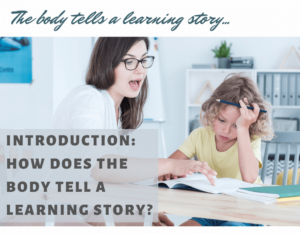 (with a particular focus on the neurodevelopmental processes that impact learning success). This section includes a basic introduction to what neuromotor and sensory immaturity can look like in a classroom setting and why you need to pay attention to it, what functional confusion is and how it can impact learning success.
(with a particular focus on the neurodevelopmental processes that impact learning success). This section includes a basic introduction to what neuromotor and sensory immaturity can look like in a classroom setting and why you need to pay attention to it, what functional confusion is and how it can impact learning success.

2. The Balance and Co-ordination Story. Why are balance and coordination key components of learning success? How does our balance impact reading and learning success?

3. The Vision Story. Vision is more than being able to see clearly. Learning how the eyes work together to help support learning processes can make the difference for a child struggling to learn to read, write, participate in sports etc. What is the “vision story” in learning success? How do you as a teacher recognise vision-based challenges that impact learning success? What does this mean for you as a teacher?
4. The Hearing Story.  What are some of the complexities of hearing that can impact the learning experiences of students in our classroom? What is the “hearing story” in the body to brain learning approach? This is more than just being able to hear well. What does this mean for you in your classroom?
What are some of the complexities of hearing that can impact the learning experiences of students in our classroom? What is the “hearing story” in the body to brain learning approach? This is more than just being able to hear well. What does this mean for you in your classroom?
5. The Movement Story.  Why do movement and posture contribute to learning success? It’s not about exercise and strength, rather, it’s about how we, as humans, use movement to develop and train our brains for learning. The movement story starts early, but we can enhance those processes at any time in our lives using principles of neuroplasticity. We move to learn and we learn to move — what does that mean for you as a teacher?
Why do movement and posture contribute to learning success? It’s not about exercise and strength, rather, it’s about how we, as humans, use movement to develop and train our brains for learning. The movement story starts early, but we can enhance those processes at any time in our lives using principles of neuroplasticity. We move to learn and we learn to move — what does that mean for you as a teacher?
6. The Teacher’s Story.  An interview with two Australian teachers who have used the “Body to Brain Learning” approach in their classrooms and schools with fantastic results for the students (behaviour and academic results), themselves — professionally and personally (increased professional satisfaction and time-saving perspectives), and for the school in general (“It has changed our whole school.”)
An interview with two Australian teachers who have used the “Body to Brain Learning” approach in their classrooms and schools with fantastic results for the students (behaviour and academic results), themselves — professionally and personally (increased professional satisfaction and time-saving perspectives), and for the school in general (“It has changed our whole school.”)
Sign me up for the wait-list & course updates.
Course delivery details:
It’s all online.
- Each week you will gain access to online course materials (45 – 50 minutes in total) focusing on key aspects of How The Body Tells a Learning Story TM
- You will be provided with prompts for triggering thoughts, discussion points and reflection to use in your professional context to support your learning and
- you can download worksheets to support your learning.
- Use the online presentations as an opportunity to take notes and jot down questions to discuss in regularly scheduled, online 1-hour live Q & A sessions with Dr Christine Payard (PhD), Director of Integrating Thinking(R) and founder of the Body to Brain Learning (R) Professional Learning Series & your instructor.
- The online discussions/tutorials/Q& A sessions offer you an opportunity to ask questions about your school context, what you see and what it may mean for the students in your classrooms.
- Every topic covered in “How the Body Tells a Learning Story” includes practical activities to illustrate the concepts discussed in the presentation so that you gain some insight into the experiences we are talking about in this programme.
- This is where the theory of a neuro-developmental learning approach starts to meet practice in your context.
“How the Body Tells the Learning Story” provides you with insight into the motor and sensory components of learning and how these aspects of learning can complicate learning experiences in life, in a classroom or in an extra-curricular setting. It’s about identifying the body cues that help us know our students better and tell us HOW they learn.
Aligned to AITSL standards, this course provides you with up to 12 hours of professional learning presentations and conversations that can contribute to continuing professional learning/development records.
A certificate of participation can be made available on completion of the course on request.
“This way of working, knowledge and understanding will help you answer questions about what you see in your students’ behaviour and posture in the classroom AND what that means for their learning and your teaching. It’s not just about what they think or what motivates them, it’s about what their body allows them to do in your classroom. Sometimes the body just doesn’t help academic learning and we need to understand why and how that works for ALL of our students — particularly when it comes to delivering the curriculum.”
Dr Christine Payard (PhD), Neurodevelopmental Educator
Want more information?
Sign me up for the wait-list & course updates.
How the Body Tells a Learning StoryTM articulates with and leads to other professional learning opportunities provided by Integrating Thinking through its Body to Brain Learning® Professional Learning Programmes and affiliate training through INPP Australia.
Note: Pricing for school-based group approaches in this course can be negotiated. Contact: Chris@integratringthinking.com.au for more details.
